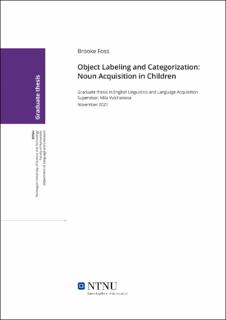| dc.description.abstract | There are many studies that point to children learning and producing nouns earlier than words in other categories because of the nature of language directed at infants by those around them. Children pay attention to things in their environment or have their attention directed to them by others. If a child’s attention is repeatedly drawn or directed to a particular object they will most likely learn and produce the word associated with it earlier than a word or object they do not interact with as often. Since concrete objects and their labels tend to be nouns, this category is among the majority of words that children receive and produce early on. To examine this link between language and categorization and early production of nouns, CHILDES database is used as a dataset. The social aspect of language learning is a factor in nouns being learned early. Adults and peers alike reference objects in the surrounding environment that the child can interact with. This concrete representation of a word leads to learning of the specific word. The nouns received and produced by children aged 12-60 months is examined in comparison to verbs, adjectives, and adverbs. Studies conducted with children aged 12 months to 60 months provided the data for the study. The study data was split into 4 age dyads to compare adult input to child language production as the child progressed in their language development. To examine the development of specific nouns and object labels I pulled words from tests meant to establish child vocabulary skills: the McArthur-Bates CDI, and Pearson CELF-5. The CDI is meant to be used with children up to 30 months, and the CELF-5 for child 60 months and older. A visual survey of the data was conducted on the frequency of production by adults and peers in comparison of the production by children. The visual survey conducted indicates that frequency of input from adults does indeed influence children to acquire words and object labels in the noun category from an early age. | |
